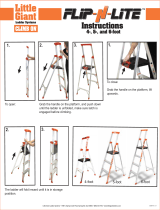
6
Harness Adjustment and Use
Tongue Buckle
I. The most common leg closure type with
function similar to the belt holding your
pants. Ensure that straps are not twisted.
II. Put open end of strap with grommets
through the buckle, pull until snug on the
leg and engage the tongue into a grommet.
III. User MUST ensure that webbing ends are
tucked into the web keepers to keep this
type of buckle connected while in use.
Failure to properly secure the leg strap
ends in the keepers could result in
unintentional disengagement.
Mating/Pass-Through
Buckle
I. Ensure straps are not twisted and the
loose end is on the outside.
II. Pass the buckle with the center bar
through the open buckle. The slot will
assist. Tug to ensure buckle is in place.
III. Pull the webbing to tighten the strap
so there is a snug t.
IV. User MUST slide plastic keepers to
strap end or nd other location to tuck
end to ensure there are no loose and
dangling ends.
Quick Connect
I. Ensure straps are not twisted and the
loose webbing end is on the outside.
II. Pull webbing through adjuster to loosen
or tighten until snug.
III. Insert male connector into buckle, tug
straps to verify rmly engaged.
IV. User MUST slide plastic keepers to
strap end or nd other location to tuck
end to ensure there are no loose and
dangling ends.
Torso Length Adjuster
I. The torso adjuster ensures the overall t
of the harness. Check to see that the
sub-pelvic strap is situated below the
buttocks. If it is too high the torso adjuster
should be loosened to lower the
sub-pelvic strap. If it is too low the torso
adjuster can be tightened to raise the
sub-pelvic strap.
II. To shorten or lengthen the torso webbing
push the top of the torso adjuster down
so it is horizontal.
III. Pull up either the inside web to lengthen,
or pull up the outside web to shorten the
torso length.
For BaseWear harnesses, separate the
small mating buckle from the larger
pass-through to allow web to ow
through the torso adjustment.
IV.When at the right length, slide the lower
plastic keeper down near the torso
adjuster and the upper plastic keeper up
so the webbing end is not dangling.
Webbing Keepers
All webbing ends are equipped with
plastic webbing keepers, which are
important to the safe use of the harness.
Sliding one keeper close to the buckles
ensures the buckle can’t be accidently
opened or moved while in use. Sliding
the other close to the end of the strap
keeps it from being loose and dangling
and a possible snag hazard.
Joining belts to harnesses
Some Werner harnesses made without
integrated belts have loops through which
accessory belts can be looped, joining
the accessory to the harness. The loops
are found on the inside of the harness
webbing, below the impact indicators.
Choosing and Fitting the Right Harness
Harness Attachment Locations
POSITIONING
These harnesses have D-Rings located at the hips for use with positioning
lanyards to allow for hands-free working in vertical structure applications
STANDARD
For fall arrest only, features only a dorsal D-Ring on the back.
CLIMBING
For climbing applications and attachment to fixed ladder safety systems,
these harnesses include a frontal attachment point.
CONSTRUCTION STYLE (POSITIONING WITH BELT)
Construction harnesses feature belts and additional attachment points for
a variety of applications. The belt allows users to carry tools, and additional
padding improves user comfort.
RETRIEVAL
D-rings on the shoulders are used for lifting or lowering a user, typically in
confined space or rescue applications
100 (45)
120 (54)
140 (63)
160 (73)
180 (82)
200 (91)
220 (100)
240 (109)
260 (118)
280 (127)
300 (136)
310 (145)
SMALL
MEDIUM/LARGE
UNIVERSAL SIZE
X-LARGE
XX-LARGE
6’8" (2.03)
6’6" (1.98)
6’4" (1.93)
6’2" (1.88)
6’0" (1.83)
5’10" (1.78)
5’8" (1.73)
5’6" (1.68)
5’4" (1.63)
5’2" (1.58)
5’0" (1.52)
4’10" (1.47)
WEIGHT - LBS (KG)
HEIGHT -'/IN (M)
Full Body Harness Sizing Chart
Harness closures and keepers ensure proper harness fit. which is of fundamental importance for safe use.
Chest straps should fit across the middle of the sternum. not higher or lower. leg straps should be snug.
Adjusting the leg straps too loosely will cause injuries in the case of a fall. Correct harness adjustments will
place the sub-pelvic strap snugly below the buttocks, the position necessary both to absorb energy in the
case of a fall, but also to provide somerelief from suspension trauma after a fall has occured. correct
sub-pelvic position is the result of the correct combination of all the harness adjustments.
Adjustment
















